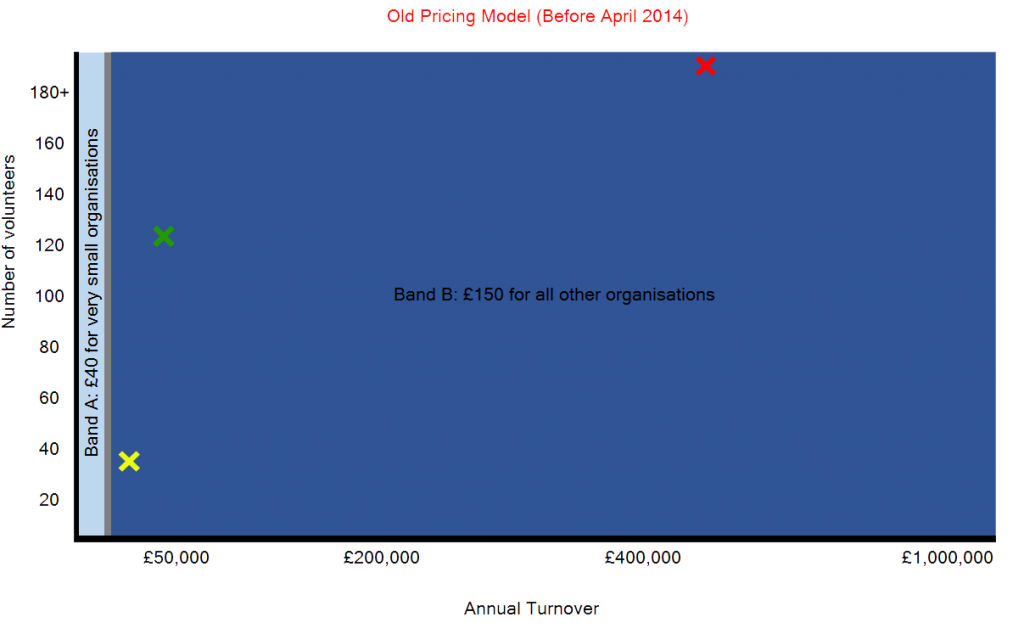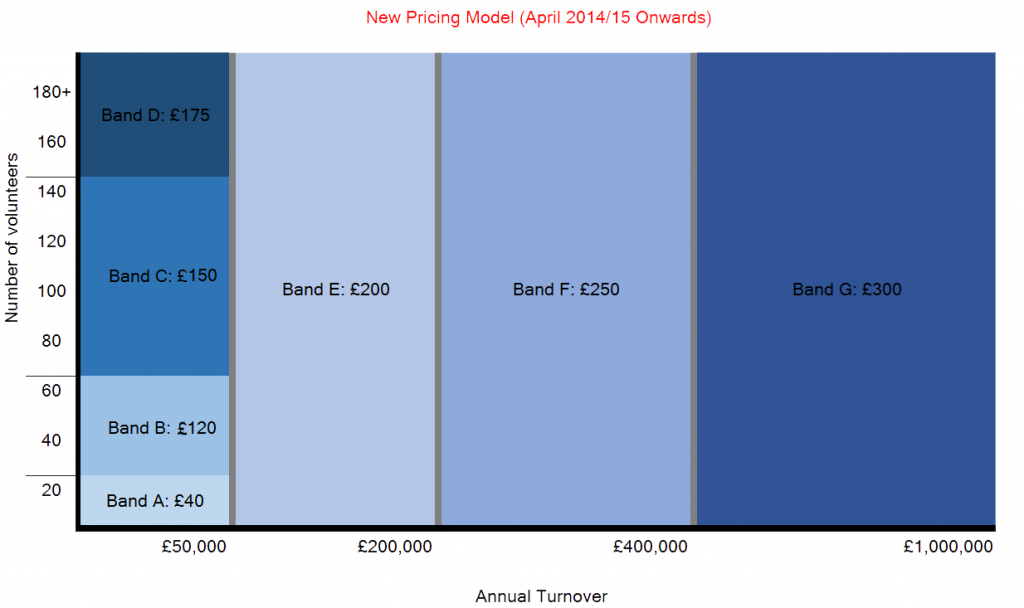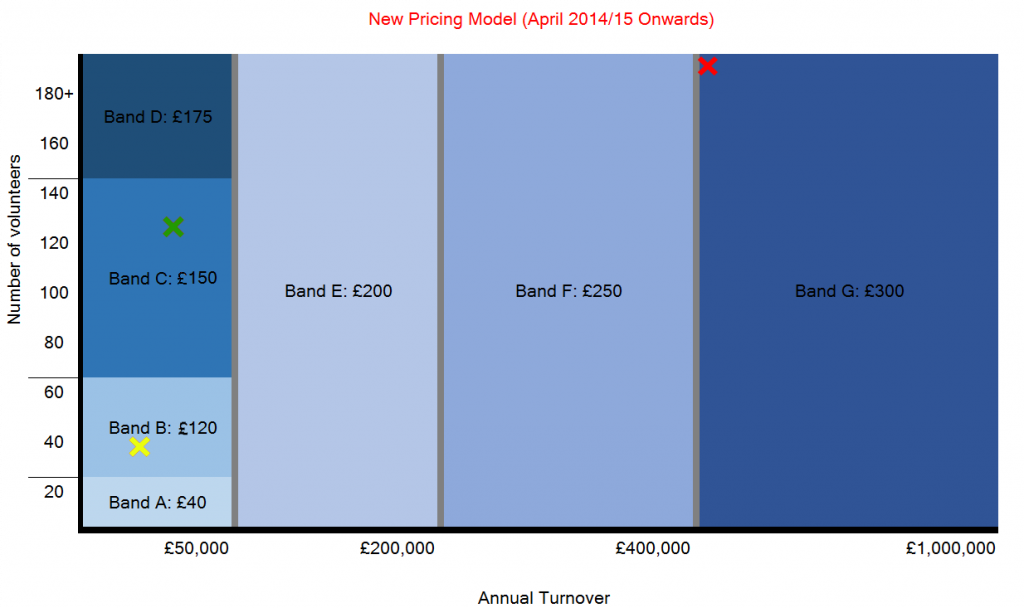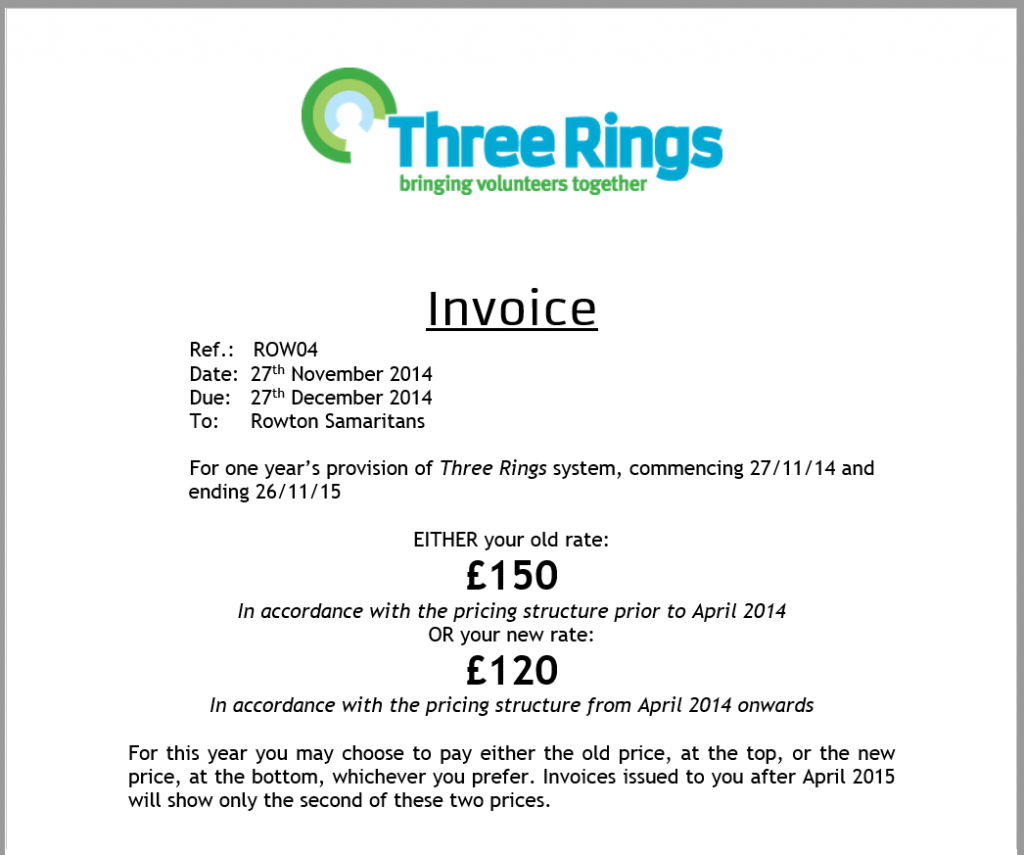Summary
Starting on the 1st of April 2014, Three Rings is changing our pricing structure for all new organisations.
Until 1st of April 2015, existing organisations will be able to pay an invoice calculated on either the old system or the new system (whichever’s cheaper for them). From April 2015, everyone will be invoiced on the new pricing structure.
For most organisations – especially those with lower turnovers – the new pricing structure should mean they either pay the same as they pay now, or even less. Organisations with higher turnovers will pay a little more, up to a maximum of £300 per year for those with a turnover between £400,000 and 1 million pounds per year.
Why are prices changing?
We haven’t changed the cost of Three Rings since we first started charging for the system in 2009. During that time the profile of organisations using Three Rings has changed dramatically. We now support Samaritans branches, Nightlines, Community Stores, volunteer-run libraries, and a variety of other helplines and voluntary organisations large and small.
As the number of different organisations benefiting from Three Rings has grown, our old “£150 for everyone” pricing structure has grown increasingly unfair for some of our clients. If you’re a small charity with a turnover of £14,000 a year, that £150 takes up more of your budget than if you’re a charity with a turnover of £220,000. We wanted to address that imbalance by introducing a new pricing structure that scales in a more reasonable way.
Here’s a visual representation of the way our pricing structure’s worked up until now:

You can see three crosses on that picture. They each represent a fictional – but plausible – organisation using Three Rings. Working from the bottom left upwards towards the right, you can see:
- A yellow X down near the bottom left representing Little Stapleton Community Stores. They’ve got 35 volunteers, and an annual turnover of just £17,000.
- A green X at centre-left representing Nanway Samaritans. They’re a moderately-well-off Samaritans branch, with 125 volunteers and an annual turnover of around £29,000.
- A red X for Midlands SuperHelpLine at the top centre right. They’re a big, well-funded organisation with 195 volunteers on the books, and a turnover of £497,000.
…Under the old pricing structure, all three organisations pay £150 per year. Which is fine by us – Three Rings isn’t here to make money! – but it isn’t fair on all those organisations.
Proportionally, Little Stapleton Community Stores are spending much, much more of their budget on Three Rings than SuperHelpLine are, because they’ve got less money to start off with, and the old pricing structure completely ignores variations between organisations.
We’ve always been proud of the fact that Three Rings is flexible enough that it can adapt to the way your organisation works, but we’ve never reflected that flexibility in the price.
How we planned a new structure
We wanted to introduce a fairer pricing structure that didn’t hurt smaller organisations. And it took a long time. Here at Three Rings our volunteers have been coming up with new pricing models – and discarding them – for most of the past year. We wanted to be sure to get this right, to make sure nobody faced sudden increases in cost, and to make sure we could still make enough money to operate without taking advantage of our users.
In the end that evolved into four key principles which helped guide us towards a new price structure:
- Under the new structure, most organisations using Three Rings should either pay less for the service or see no increase in what they pay.
- Whatever new pricing plan we picked should be simple enough that any prospective organisation could look at it and easily see how much Three Rings was going to cost them.
- Everyone using Three Rings should be charged based on their resources, not on what features of Three Rings they chose to use…
- …But even organisations with very high turnover shouldn’t face exponential price increases.
How the new prices work
Using our four key principles, we sat down and developed a new pricing structure that put organisations into one of seven bands. The bands were mainly centred on each organisation’s annual turnover, with finer gradation for small organisations with a turnovers of £50,000 or less.
It took a few goes, but we eventually found something that didn’t mean Three Rings would suddenly start running at a loss (or end up with too much of our users’ money!), and which met all of our four criteria for a fairer pricing structure:

Under this new structure, organisations with an annual turnover of £50,000 or less are split into the lowest four price bands:
- £40 per year for those with 20 volunteers or fewer
- £120 per year for those with between 21 & 60 volunteers
- £150 per year for those with 61 – 140 volunteers
- £175 per year for those with over 141 volunteers.
Band A is specifically designed for brand new organisations that are just getting off the ground – very much like our old discretionary price rate of £40 which we occasionally offered to very small, badly-off organisations that wanted to use Three Rings.
For bands B, C & D we’ve worked hard to ensure the price difference between the bands moves smoothly: the last thing we want is for organisations to avoid taking on new volunteers in order to save themselves from a sudden jump in costs!
For organisations with a turnover of more than £50,000 we don’t price by volunteer numbers and instead work by turnover alone:
- Between £50,000 and £200,000 we charge £200 per year
- Between £200,000 and £400,000 we charge £250
- Between £400,000 and £1,000,000 we charge £300.
Theoretically, there’s an eighth band, Band H, for organisations with a turnover of more than £1million: we’ll price that band on an organisation-by-organisation basis if it ever comes up!
For a quick example of what that means, let’s look again at our three fictional organisations from before: Little Stapleton Community Stores (yellow X), Nanway Samaritans (green X), and Midlands SuperHelpline (red X):

Under the new system, Midlands SuperHelpLine, with their £497,000-per-year turnover pay the most: they’re in Band G, so they’re now paying £300 per year instead of £150. Nanway Samaritans are in Band C, and so they pay the same as they paid before: £150 per year. And Little Stapleton Community Stores are now paying just £120 per year, down in Band B. If you compare this to the first illustration, showing the old system, we hope you’ll agree the new pricing structure is a lot fairer!
Of course, any special discounts we’ve agreed with people – for example the 20% discount we offer to Samaritans branches paying regionally, will still apply: each branch will be placed in the appropriate band, and the 20% discount will be applied before we calcualte the total value of the invoice given to the region.
When does this change happen?
We want to be as fair as possible about this. The majority of our customers will pay us less money, or the same amount of money, under the new pricing structure. But we realise some organisations, with higher turnovers, will find themselves paying more. We don’t want to upset anyone’s budget planning, so if you’re already using Three Rings then you don’t have to pay on the new structure until April 2015, unless you want to.
We’ll start to issue invoices following the new pricing structure from April 1st 2014. If you’re a new organisation, you’ll just see an invoice priced according to your band. If you’re an existing Three Rings customer, your invoice will show the old, £150 price, and the price you’ll pay under the new pricing structure.
If you want to start paying on the new structure (for example, if your organisation is in Band A or Band B and is about to pay less for Three Rings) then you can start paying on the new scheme, so you start saving money as soon as possible.
If you’re organisation is in Band C, it won’t make any difference to you – you’ll be paying £150 under either the old plan or the new plan.
If you’re in Band E, F or G, then you can still pay the old price of £150 until 1st April 2015. After that, you’ll be invoiced according to your new band, but you get plenty of time to factor that into your budget planning before it happens.
Here’s a mock-up of one of these “transitional invoices” to make things clearer:

We expect that the majority of our customers will pay the lower of the two rates during this transitional period (although, if you want to pay the higher rate, that’s fine too!). In the long term, though, our turnover will remain more or less the same under the new pricing structure. We don’t mind our income dropping for a little while – as we showed with our 10th Anniversary Discount! – and we certainly don’t mind it happening when it’s part of our plan to ensure that the pricing of Three Rings remains fair to everybody.
The price of Three Rings hasn’t changed since we first started charging for the system five years ago. It’s a pleasure to say that, now a change in pricing is finally being introduced, it’s one that will help to make Three Rings the best and most affordable choice for more voluntary organisations than ever before.
